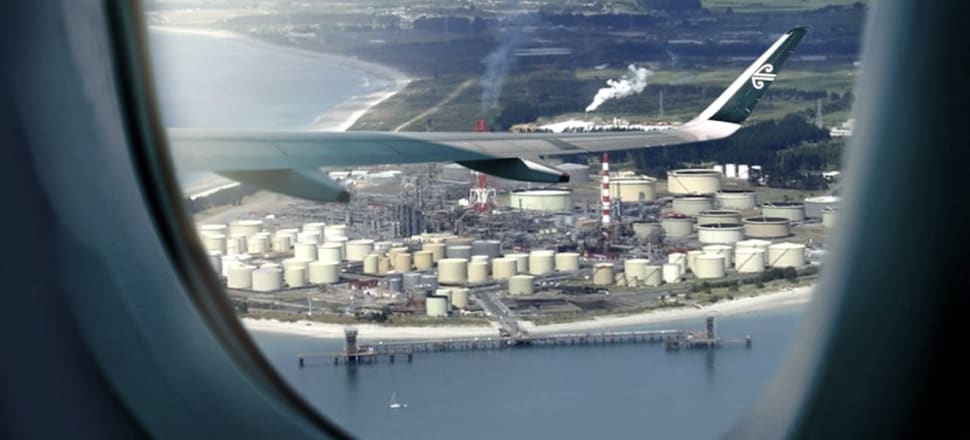
The Government is chipping in an initial $575,000 to investigate if the decommissioned Marsden Point refinery can be used to make green hydrogen for synthetic jet fuel – but the energy-intensive process would have to give back to NZ's electricity grid
Analysis: There are those who would argue decarbonisation means a definitive step away from air travel. The question is, can this shrinking world credibly return to an era of isolated island states that trade only via the slow boat to China?
This strategic question is more pressing for New Zealand than almost any other country.
For those who accept that local production and digital engagement with trading partners will never provide a complete answer – that long-haul air flights will be part of our future – an announcement yesterday is an important one.
READ MORE: * Grim news for the planet, great news for Channel Infrastructure * Marsden Point role confirmed in generational leap to biofuels * NZ's first hydrogen trucks hit the road
Fortescue Future Industries and Channel Infrastructure, which owns fuel import terminal Marsden Point, hope to use the decommissioned refinery to produce 60 million litres a year of synthetic aviation fuel (eSAF) – enough, they say, to meet 3 percent of New Zealand’s pre-Covid jet fuel needs.
This steps through several energy sources. They are signing understandings with electricity generators Mercury, Manawa, Top and Yinson to develop new renewable projects, as well as building their own big solar farm.
Using this power and more, they'd produce energy-intensive green hydrogen at the 300MW plant – then use that to manufacture eSAF. That would be blended with imported fossil fuel and sent down the pipeline to Auckland Airport.
We knew Channel was considering hydrogen; we knew they were looking at low-carbon jet fuels – but few observers had linked the two.
The media may not have been paying close enough attention, because Fortescue’s country manager Amy Barrett foreshadowed this in comments to law firm Minter Ellison, just before Christmas. “People are searching for the one perfect energy answer, which is simply not possible,” she said. “It must be a suite of answers.”
Fortescue has also done a side deal with Air NZ to investigate eSAF’s use, with the intent being that Air NZ be the foundation customer once the Marsden Point project becomes commercially viable.
Like Fortescue, Air NZ has a lot of green eggs in a lot of baskets. It’s also looking at e-planes for domestic hops and hydrogen fuel cell jets for long-haul – but this technology is a long way off being manufactured at scale.
Airbus hopes to produce its first hydrogen jet by 2035; even in the best-case scenario, New Zealand wouldn’t have a fleet of hydrogen planes until 2040 at the earliest. It’s too far away, on New Zealand and the world’s urgent decarbonisation journey.
If we are to keep flying, we need transitional solutions. Newsroom Pro reported last month on two new Air NZ partnerships: one with tech darling LanzaJet to make sustainable aviation fuel using forestry residues; another with Fulcrum BioEnergy using municipal waste.
Already, Air NZ has flown jets powered by imported biofuel made from renewable waste and residue raw materials. The airline was "incredibly committed" to getting its fleet up and running on SAF, chief executive Greg Foran said at the time. "The future of travel relies on low-carbon air transport."
According to a Mission Possible Partnership report, current projects in the global pipeline for SAF production are insufficient and need to be scaled up by a factor of five or six until 2030, to enable the massive scale-up that will be required to achieve net zero by 2050.
This week’s announcement positions New Zealand as a first mover in the valuable synthetic fuel market, according to Fortescue. “For New Zealand, domestic eSAF production would provide a greater degree of fuel security and support development of the local green hydrogen industry,” argues chief executive Mark Hutchinson.
Producing eSAF at Marsden Point is a step beyond previous talk of using Northland’s forestry residues to make biofuel at the former refinery. That work is now on indefinite pause. Energy Minister Megan Woods had indicated she was sceptical about the plant making biofuel – she told Cabinet that forestry biomass fuels would be better produced at wood production sites.
The Government is, however, supporting this hydrogen-to-eSAF investigation, Woods says.
That's already funded to the tune of $575,000 from the Energy Efficiency and Conservation Authority, with the potential for more to come from MBIE and New Zealand Trade and Enterprise. EECA would require demand response benefits for the electricity market – for instance, cutting power usage when hydro lakes are low or there's a cold snap.
Woods says: "This is exactly the kind of world-leading innovation that could make a big difference in low-emission transport and travel."







